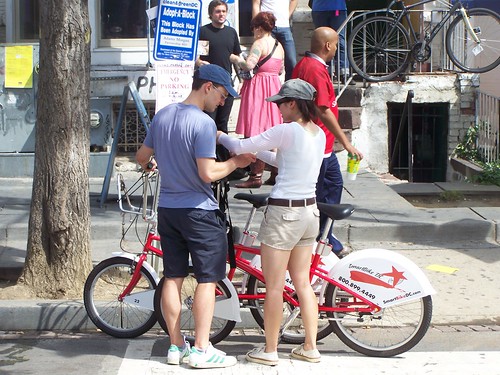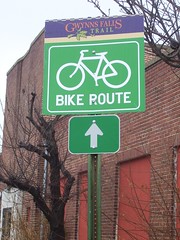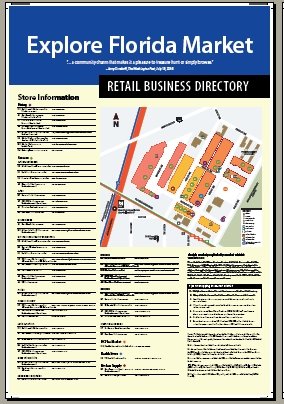Car culture vs. urban culture and bicycling

Bikesharing at Adams Morgan Day 2008.
Driving is about being separated from the world. Walking, bicycling, or using transit is about being connected to others, being a part of the world.
Tom Matlack in "Is Boston Ready For a Revolution?" from this coming Sunday's Boston Globe Magazine, writes about Velib, the massive bike sharing system in Paris, with 20,000 bicycles and set to expand to Paris' inner suburbs, and the implications for Boston, which is working to become more bicyclist-supportive and is considering a bikesharing program.
Matlack writes:
Boston is a different city on a bike. As the fresh air hits your face, you see things you would miss from a car: the sun reflecting off a historic church steeple; an old lady who wears a different, outrageous hat every day; intricately carved brownstone doorways. If you look closely, it doesn't feel like New York or Chicago or Los Angeles. I always swear I must be in London or Paris. No other American city has the history and architecture and grandeur of ours, and it's best seen on two wheels.
But there is one problem with taking in the views while pedaling along -- you might get killed. Riding a bike in Boston traffic requires a fundamental decision: Play it safe or go for broke. My strategy has always been to go the same speed as the cars and try to intimidate automobile commuters. It's only a mile down Beacon and then Commonwealth Avenue from my house in Coolidge Corner to my office on Newbury Street, but on a bike it's treacherous. There are no bike paths on those streets, and morning commuters are testy. I once saw a scrawny bike messenger get into a game of chicken with a cabbie. It didn't end well. The two men screamed at each other, nose to nose, on the corner of Commonwealth and Dartmouth. Then the messenger landed one decisive blow to the chin of the chubby cabdriver before getting back on his bike and riding off.
As the article intro says: "But as one visit to Paris reveals, bike share is about more than cool racks and shiny two-wheelers."
In the suburbs in particular, non-drivers are stigmatized.
But in the process of what we might call the suburbanization of the city, a majority of the people who live in DC are shaped by the suburban automobile-centric paradigm of land use and mobility planning--so they see the car as central, and walkers and bicyclists and transit, for the most part, as an imposition.
The kind of Boston environment described in the Globe article is similar to that in DC, and in DC proper, we have about 2% of daily commuting trips made by bicycle (more when you count trips into and out of DC by some suburban commuters). But still drivers who kill bicyclists aren't charged with vehicular manslaughter, see "No Charges to be filed in Swanson Case" from Washcycle, and the culture is still oriented to drivers, who see walkers and bicyclists and transit riders as the "other."
What is interesting is how the article describes the presence and utlization of the Velib bicycle sharing system as changing the culture and perception of bicycling. I.e., there was a photo in Vogue Magazine of the model Agyness Deyn on a Velib. And Jessica Alba...

Photo by Bauer Griffin from an entry in Cyclelicio.us.
From the article:
James Houghton, a venture capitalist and longtime Beacon Hill resident, happened to take his family to Paris for a sabbatical just as Velib was being launched. "I was not much of a biker before we went to Paris, but the Velib was one of the highlights of our year," he says. "It was a great way to get around." When his family returned home, he says, he started riding everywhere and became a convert to the joys of the bike commute. "The main difference is that the culture in Paris is now much more bike-friendly. Boston may have a little work to do on that front, but I have no doubt that a well-run bike-share program would not only work well here but could help transform the city."
So it will be interesting to see how as DC's SmartBike bicycle sharing program is expanded, if it can have the same kind of impact. It hasn't been launched with the same level of pervasiveness and fanfare as the Velib system. (I want to interview some of the members of SmartBike in DC, to get a sense of what the user types are, and why they use SmartBike instead of an owned-bike.)
It's still more of a novelty. But Washcycle writes that the system will be expanded, in part through Federal Government economic stimulus funding. See "SmartBike Expansion." This will add up to 30 bike sharing stations.
Plus, the construction of DC's first Bike Station, at Union Station is underway and should be finished some time this year.

DDOT rendering, Bicycle station at Union Station, Washington, DC.
And the city continues to expand bicycle lanes. Maybe not always perfectly, but it is a network that is expanding.
Plus, the Metropolitan Branch Trail is actually moving along. For at least 18 months, DC's Department of Transportation has had a project manager pushing the construction along. I am not sure when it will be finished, but it is safe to say that after first being proposed in an op-ed by Patrick Hare, a then planner for Montgomery County and a then resident of Brookland, in the Washington Post around 1990, that there is an end date, near, for when it will finally be reality.
So maybe, despite all my criticism (and remember criticism can come out of great love and a desire for excellence), such as:
1. Needing to create some separated bicycle "cycle" tracks and incorporating bicycle-supportive infrastructure in all road rebuilding efforts

Separated bicycle lane in New York City (Manhattan), southbound 9th Avenue from 23rd Street to 16th Street. Photo from BeyondDC.
2. Better signage

Bicycle Route 40 sign, Austin Texas.

Gwynn Falls Trail Sign, Bayard Street, Baltimore
3. Bicycle maps at Metro Stations and in Bus Shelters

Bicycle map posted in a bicycle parking shelter, New York City. (Photo source unknown.)
4. Incorporating information on bicycle sharing stations and support facilities in wayfinding signage systems

Baltimore's wayfinding signs do a better job denoting transit infrastructure. Let's add information on bicycling infrastructure to the signage system.

This proposed wayfinding directory for the Florida Market district has incorporated information about bicycle lanes, air compressors, and other information into the map as a result of input from Washcycle and others. This idea should be extended to the maps and directories delivered via the wayfinding signage system throughout the city. (This image is of the first iteration of the sign, which has been updated a number of times subsequently. The most current version, but still awaiting a few changes, is online here.)
... among others (see the past blog entry "Ideas for making bicycling irresistible in Washington, DC" for many more), I think we are starting to see some real accomplishments.
Labels: bicycling, car culture and automobility, transportation planning, urban design/placemaking



0 Comments:
Post a Comment
<< Home